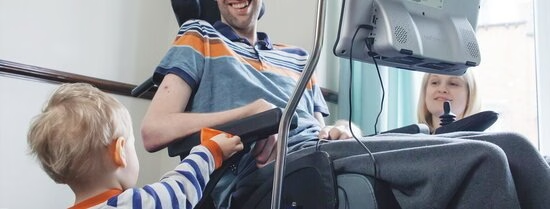Brain and spinal cord implants that improve hearing, reduce pain, or even enable ALS patients to communicate again: the field of Neuro-Engineering seems to be on the fast track towards accomplishing its ultimate goal of enhancing or even replacing the nervous system. In her recent master thesis in Philosophy, student Sadaf Soloukey argues that it’s time to move beyond fascination for the medical possibilities only. Philosophy’s insights on the human experience of body ownership can widen doctors’ view to help them better understand how these technologies affect their patients’ lives and how patients can be helped to better incorporate these ‘strange’ implants into their daily lives. For her thesis, Soloukey won the prestigious Jan Brouwer Scriptieprijs 2018.
Congratulations!
“Thanks.”
Describing the interface between man and machine you have studied Ms. A. Who is she?
“Ms. A, the case that I studied, is a real patient, who became world-famous when she received, as one of the first ALS patients ever (Amyotrophic Lateral Sclerosis, a disease which affects the neurons that control voluntary muscles), a brain-computer interface by the hands of the neuroscientific research team in Utrecht, led by professor Nick F. Ramsey. At the time of the informed consent, Ms. A was 58 years old and in a locked-in state due to her disease. She was completely paralysed, but thanks to an implant in her brain can use brain waves to control a speech computer. The electrodes placed over the cortile motor movement area of the brain, were hooked up to decoding software. The aim of this software was to decode electronic brain signals picked up by the electrodes to actual intended movements and eventually, letters. This meant that the software had to be ‘in tune’ with her pattern of brain signals. By continuously performing training tasks, which entailed withholding or activating ‘brain clicks’ on a computer screen, her brain can now communicate through a screen.
I argue that we should also see this screen as an ‘external implant’, a new extension to her body. In fact, people might even look at the screen more often than at her face. That requires or even demands decisions about how to organise such a screen. Does she want a plain keyboard? Does she want a row of smileys? Or would she prefer standard sentences like 'I love you’?” How would you design your new face on a screen?

What do you recommend?
“It’s not only doctors that I would like to advise. The people who make the devices need new insights too. For a long time, we have been fascinated by the technical possibilities. Now I think it's time for the second phase., in which we not only look at how we introduce a device into the body technically, but also how someone experiences it. How a patient can make such a device their ‘own’, and how engineers can facilitate in that. For example, there are implants that regulate chronic pain by stimulation right above the spinal cord. With that device you are not allowed to move wildly, nor are you allowed to lift heavy things, or drive with the device activated. For someone with an office job at the end of the street, this has very different consequences than for a house keeper who has to lift heavy things all day
But this research also has important recommendations for doctors. Doctors should have the time to discuss and to take into account what it means for a patient to receive a neuro-implant,more than the current doctor-patient consultation structures allow in a clinical setting. There are patients who see their device as just a box in their bodies. Others see it as an important part of themselves. The way someone perceives such an implant has many implications. While some patients have reported to be so proud of the device they would want a zipper in their back to proudly show the world their awesome gadget, other have reported to feel less desirable or more conscious of their body since the implantation of the relatively well-hidden implant. I argue that there should be room for these discussion between a doctor and a patient before, during and after the implantation process, to cater for the ‘existential reorientation’ a patient has to go through.
By allowing the patient and the doctor to oscillate between seeing the body as an object, a machine with a problem to fix using engineering, and the body as lived, as body which needs to incorporate the engineering device as its own in order to be able to function properly, the doctor and patient will cover all relevant grounds of the process.”

Sadaf Soloukey
You won a prize, you finished your thesis in Health Economics and are finalizing your thesis in Neuroscience. What’s next?
“I will start my PhD in Neuroscience and Neurosurgery this September. Among other things, I will deal with spinal implants for people with paraplegia.”
Want to know more? Read Soloukey's master thesis 'Embodied Neuro-Engineering: Phenomenology and Neuroscience on the Same Team (2017)' here
Photo eye tracking computer (C): Tobii

